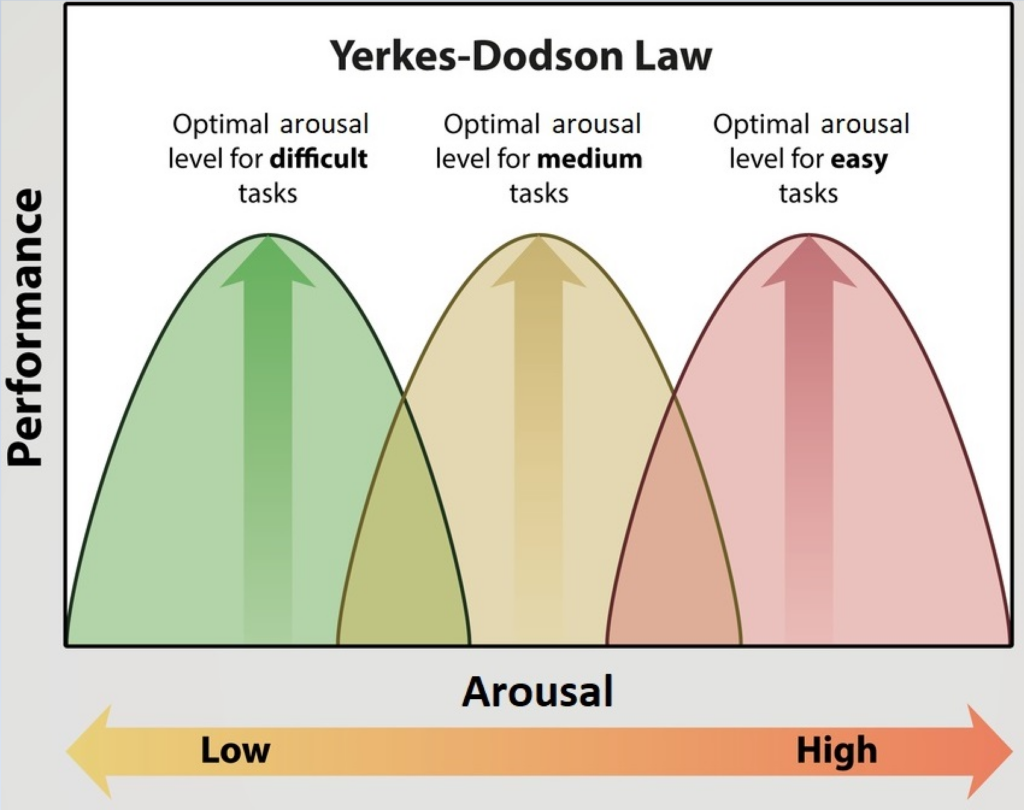Chapter 3: Optimizing Performance
To maximize learning performance, it is crucial to understand the following as it relates to neuroscience: motivation, neural arousal and skill acquisition.
Motivation
Prior to 1985, the dominant belief of motivation came from the behaviourist view of extrinsic rewards acting as reinforcements (O’Hara, 2017). Examples of such “external manipulation” include grades, parental praise and avoiding punishment. In contrast, intrinsic motivation is defined as the spontaneous tendency “to seek out novelty and challenges, to extend and exercise one’s capacity, to explore, and to learn” (Ryan and Deci, 2000, p. 70). This has been found to enhance learning, performance, creativity, optimal development and psychological wellness (Di Domenico and Ryan, 2017). However, the key to long-lasting motivation remained somewhat enigmatic until psychologists Richard Ryan and Edward Deci collaborated to form their theory of intrinsic motivation.
Self-Determination Theory (SDT)
Under the assumption that people are always actively seeking to grow and improve, Deci and Ryan postulated that personal well-being and the best quality motivation is directly related to the satisfaction of three basic psychological needs:
- Autonomy – feeling of control over one’s learning
- Competence – feeling effective and capable of achieving desired outcomes
- Relatedness – feeling connected to others and a sense of belonging
Interestingly enough, according to Van Praet (2022), established research has shown that smaller rewards can greatly affect attitudes, emotions and loyalty more so than larger rewards resulting in deeper levels of behavioural change. Cognitive dissonance theory suggest that these smaller incentives may be more effective because they do not undermine intrinsic motivation in the same way greater external rewards such as big discounts and free prizes do.
Exercise 3.1
(Neural) Arousal
Arousal is defined as “the state of alertness or excitement that drives a person to learn or perform a task” (Honnold, 2020). Our brain responds differently to various states of stress and anxiety, which ultimately affect our performance.
The Yerkes-Dodson Law is a model of the relationship between arousal and task performance visually represented as an inverted U curve. Low arousal results in student boredom and low motivation while high arousal results in student anxiety that stifles performance. The goal then is to find the optimal arousal level for varying task difficulties in order to maximize student motivation and performance.

Exercise 3.2
Keep in mind that students will perform differently to stress according to four factors (Pietrangelo, 2020):
- Skill level – New tasks can provide motivation presented in the way of a challenge.
- Personality – Personal life experiences, beliefs, and fears will shape responses toward stress.
- Confidence – A positive attitude and growth mindset serve students well when under pressure.
- Task complexity – There is an inverse relationship between task complexity and tolerance of stress levels.
Skill Acquisition
During the consolidation phase of learning, newly acquired knowledge is integrated with existing knowledge. This process involves stabilizing new information in the hippocampus so that it becomes part of long-term memory in the neocortex. To facilitate the strengthening of memory retrieval, neuroscientists have identified several factors that effectively aid in consolidation.
- Diet – consume foods that help boost brain memory including leafy green vegetables, fish, beans, nuts, berries and olive oil.
- Sleep – REM sleep is particularly important for the consolidation of procedural memory which is essential for skill acquisition.
- Breaks – allows the brain to process information without additional cognitive load.
- Exercise – not only aids in increased concentration during initial acquisition but also stimulates the production of new neurons in the hippocampus which enhances memory and learning capability over time.
- Practice – aids in the reinforcement of newly-learned information.
Exercise 3.3
